Flowing waters are probably less frequently examined by "ponders" from a microscopic point of view, which may be because it is often much more convenient and less dangerous to take samples from the edge of a standing water than from streams with slippery stones...But therefore even in small rivulets, organisms can be found that have not yet been so well studied or are not known at all, as shown by the example here: |
|
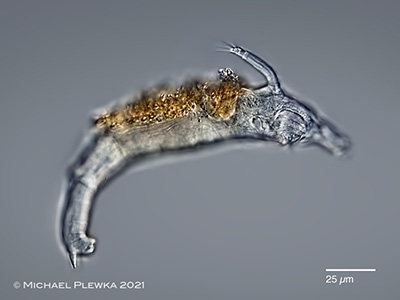 |
|
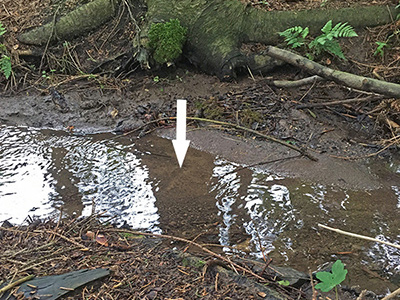 |
|
| |
| |
| |
| |
| |
| |
| |
| |
| |
| |
| |
| |
| |
| |
| |
| |
| unknown bdelloid (left) in its habitat (arrow, right); more info here >>>> |
|
|
|
|
| |
| Encentrum liepolti |
In the same site 2 months later, after very heavy rainfalls in our area, a dicranophorid rotifer was found:Encentrum liepolti. The right image shows the forcipate trophi: |
|
|
| |
| Henoceros falcatus |
|
The rotifer Henoceros falcatus is another example. This rotifer has been classified as "rare" by Donner in his book (1965). In Germany it was then found in a UV sewage treatment plant for the first time in 1984. This observation was then published in the magazine "Mikrokosmos" (1984). I am not aware of any other reports of finds of this species from Germany. Here is a side view: |
|
|
| Henoceros is a very unusual rotifer. It belongs to a family of the Bdelloidea: Philodinavidae, whose species are largely characterised by the reduced corona (hence they are not really
"wheel" animalcules). In 1998, the morphology has been described quite extensively in an Italian paper, although the animals studied probably originated from a biologist in Germany. The four large toes are conspicuous; the usual two spurs are missing, instead there is a large appendix (see arrow). The picture here shows a critter seen from the ventral side, where these typical features (incl. the reduced corona) can be seen: |
|
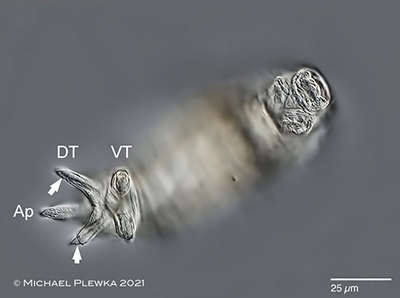 |
|
| |
| |
| |
| |
| |
| |
| |
| |
| |
| |
| |
| |
| |
| |
| |
| |
| Henoceros falcatus |
|
|
|
|
The habitat of this rotifer is described by Donner (based on the locality of the first describer (Milne 1916) ) as "clear mountain streams" (to which, unfortunately, I personally very rarely have access). However, the locality (UV sewage plant) in the Mikrokosmos report by Bendt (1984) contradicts this. Although I have been microscoping for several years, I had yet to see this species alive. I was therefore all the more surprised when I found this species in three different places within a month: twice in Brittany, whereby the sample sites were in streams that are about 30 km apart and have no connection with each other. The sites in Britanny are estimated to be 3-10m above sea level. |
|
|
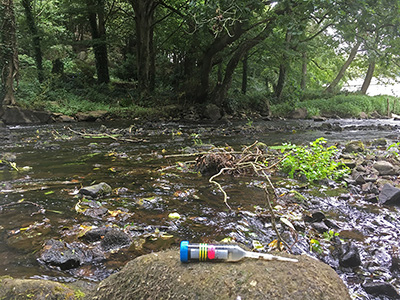 |
|
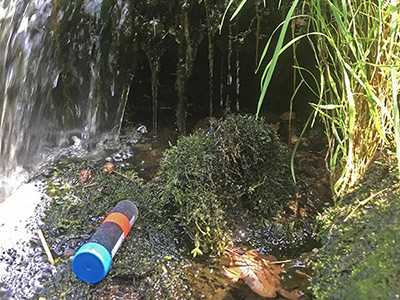 |
|
| |
|
| |
|
| |
|
| |
|
| |
|
| |
|
| |
|
| |
|
| |
|
| |
|
| |
|
| |
|
| |
|
| |
|
| |
|
| |
|
| |
Left: Le Garo; Ploguin; right: Stang-Alar; Botanical Garden, Brest |
|
|
|
|
| The third site was found at the weekend here in the Ruhr district/ Germany: the Felderbach, at a sample site that is quite small at about 20cm x 20cm. I have already examined this very spot several times this year, and found another rotifer species, which is also not yet described in the literature: |
|
|
| |
| Embata hamata |
|
Back to Brittany: The two streams mentioned above are also interesting places to find rotifers. At this point I would like to introduce two more bdelloid forms. Besides H. falcatus, a species of Embata was found there that is also typical for running waters: Embata hamata ("hooked Embata") is characterised by spurs that often protrude at right angles and by "auricle-shaped" bendable trochal discs: |
|
|
| |
| Embata commensalis? |
In the creek of the botanical garden of Brest I found another enigmatic bdelloid rotifer. Here is another aspect of rotifers in flowing waters: some of these species have adapted to hosts from the macrozoobenthos such as the aquatic isopod (Asellus aquaticus), where they live between the gills as commensals/parasites. It seems that rotifers sometimes detach from their host and can then be found without it (which then makes identification more difficult). For example, I have also found Rotaria socialis both with and without Asellus.
Western described (1892/93 ) a species of Embata that he found on this aquatic isopod. He describes this form as "at first sight similar to a Rotaria macrura", which may be mainly due to the forward orientation of the rostrum. Probably because of the eyespots he named this species Philodina commensalis at that time (Bryce then established the new genus "Embata" in 1910). The species: Embata commensalis is also found in Donner's book. It is interesting that the description in the text as well as his drawing of this species are based on the book by Bartos (1951), whose drawing, however, differs seriously in essential features from the original drawing by Western (unfortunately the Bartos text is in Czech, I have not yet found a possibility of translation)). As with many other bdelloid forms, photos of living specimens of this Embata species do not seem to exist, so that no comparison is possible. So the find shown here cannot be identified at all with the book by Donner because of the misleading presentation in my opinion, although the species is listed there; but the find largely agrees with the original description of the species Embata commensalis by Western: |
|
|
|
| |
| |
|
|
|
| |